Decorative Masonry Repairs
Catherine Woolfitt
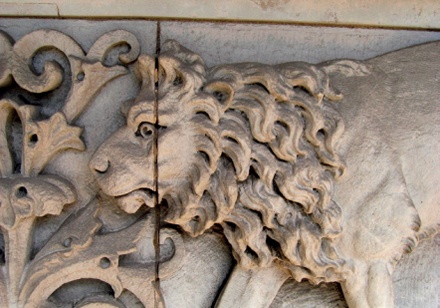 |
|
| Masonry joints through decorative elements and sculpture require special care in cutting out and placing repointing mortar and in the design of a physically and visually compatible mortar. |
An understanding of the characteristics of building stones and their weathering and decay in the external environment is fundamental to effective repair of all types of historic masonry.
Specifiers need to anticipate the physical and visual impact of any proposal to clean and repair a historic building. They should also bear in mind that cleaning and surface repair normally require listed building consent and all aspects of the proposed work, whether aesthetic or technical, need to be considered.
Historic stonemasonry facades can present a wide spectrum of challenges, and variations in stone type, date, extent of weathering and style of construction are all significant factors. Broadly, the older the building and the greater the extent of past repair and alteration, the more complex and challenging the remedial work is likely to be. Heavily decayed surfaces can be particularly demanding, especially when they are in exposed or inaccessible locations, occur consistently across a facade, or pose a threat to health and safety.
This article focusses on minor repairs to decorative ashlar masonry – that is to say, accurately dressed blocks with relatively fine joints. It therefore excludes works to rubble masonry, and major structural repair work and concentrates on facades of functioning buildings, excluding the ruined monument context. Other masonry types and contexts may present different challenges and will often demand a different approach from ashlar.
SURVEY AND UNDERSTANDING
Condition survey is the first essential step in the process of developing and planning remedial work. The aim is to gather as much information as possible about the nature of the masonry, the building stones used and the history of past repair work, and it is usually carried out in several stages depending on the level of access and whether cleaning is involved.
At the planning stage, a preliminary survey from ground level with the aid of binoculars may be sufficient to produce remedial work documents (a specification, schedule of work and budget costs), all of which will normally be provisional to some degree. For this reason it is common practice to include a provisional sum for unforeseen work, repair items which are difficult to detect from ground level.
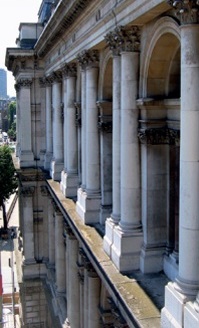 |
|
| The Whitehall elevation of the Foreign and Commonwealth Office: survey should include assessment of differential weathering and decay across a masonry facade, from sheltered, recessed areas to severe exposures, such as copings and cornices. |
The preliminary survey should consider both the individual masonry elements and the complete elevation, and an understanding of surface condition and soiling is important. Studying soiling patterns will reveal how rainwater is shed, how masonry joints function and where they fail to function properly due to localised decay.
Variation and irregularity in the deposition of soiling may relate to natural weathering but can also result from stonemasonry defects. Patches or streaks of clean stone in the midst of soiling typically indicate localised rainwater washing, which may relate to exposure, the orientation of the facade, or environmental conditions such as the prevailing wind and proximity to other buildings or trees.
Streaks can also indicate the presence of defects such as fractures or eroded perpendicular joints (the ‘perpends’) in cornices or mouldings which will eventually admit rainwater. With time, rainwater penetration will promote decay of the stone arrisses at open joints. Once the mortar joint is completely eroded, characteristic rain-washed streaks will form on soiled stone surfaces below.
It is normal practice to carry out cleaning work in advance of masonry repair for two reasons. Firstly, depending on the extent and nature of surface soiling, it can be difficult to identify and assess defects without cleaning first. Secondly, repairs made to a moderately to heavily soiled surface can be highly conspicuous – a patchwork of light blocks set within a dark ground. Indeed, even where stonework has been cleaned, repairs in new (matching) stone may appear lighter in colour next to weathered, historic stone which will have its own patina.
Typically a pre-cleaning inspection is carried out as soon as scaffold access is available. This is a general assessment to check for potential problems such as open joints and fractures that may admit water during wet cleaning work. Detailed survey normally proceeds after masonry cleaning so that all defects are readily identifiable.
Responsibility for inspection, scheduling and documentation should be clearly set out in the contract documents. All survey work should be carried out by specialists experienced in the conservation and repair of decorative masonry, and the detailed survey and condition assessment is best carried out by the contractor and specifier jointly, as this has a number of advantages: repairs can be agreed and measured more quickly, unusual or difficult repair issues can be resolved jointly, and minor intrusive investigation to understand the extent or nature of defects can be carried out immediately. Contract documents should set out the criteria for stone repair and replacement (discussed below).
COMMON DEFECTS, BUILDING STONES AND REPAIR TYPES
Stone masonry defects should be assessed individually and repairs tailored to suit the exposure and the building element. This is especially important for elaborately detailed buildings with decorative mouldings and projections such as cornices.
Repair types commonly include:
- stone indents or ‘piecing-in’ repairs
- mortar or ‘plastic’ repairs
- the installation or repair of existing lead weatherings
Stone indents can be designed to suit all conditions, but mortar repairs are sometimes more practical, particularly for smaller defects or in sheltered areas. However, as a general rule, mortar repairs will not be sufficiently durable for repair work on severe exposures (unprotected copings, cornices, ledges, other projecting mouldings/elements) although they may be suitable in more sheltered locations (with reinforcement, depending on the size and location) and can be used if necessary at ground level where their condition can be more easily monitored and they can be more readily renewed.
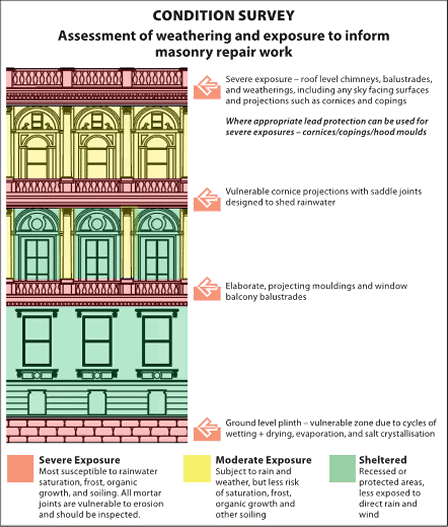 |
|
| Relative degrees of exposure and weathering: exposure is a key criterion for scheduling and specifying individual repair methods and materials. Stone in the red zones typically exhibits a greater degree of weathering and deterioration. To be durable and effective, repairs must be designed to suit the exposure. |
Repair and replacement stone should be of matching type. If the original stone is no longer quarried and reclaimed stone is unavailable, the replacement should be the nearest possible match, both geologically and visually.
Understanding of the nature of the building stone and its weathering characteristics is fundamental. The range of building stone types used historically across the UK is wide, and properties vary considerably even within a geological group. For instance among the English Jurassic (oolitic) limestones, which include the Bath and Portland groups, there is considerable variation in weathering characteristics and durability.
Best masonry practice dictates that the natural geological bedding planes of the stone should be observed and stones laid with the correct orientation of the bedding planes, relative to their location in the building. For example, ashlar facing stones in a flat wall face should be laid with their natural bedding planes parallel with the ground, not face bedded, while blocks used for projections (cornices, any element with a vulnerable soffit) should be laid with their bedding planes vertical and at right angles to the building face to avoid the risk of delamination of layers.
Failure to understand the natural features and weathering of building stone, the gradual erosion of surfaces that occurs naturally versus the accelerated deterioration that results from masonry defects, can result in flawed condition assessment and incorrect specification of repair work. It may also lead to the loss of historic fabric if masonry is wrongly condemned for replacement rather than repair.
TRADITIONAL MASONRY DETAIL AND PROTECTION AGAINST RAINWATER PENETRATION
Allied to the understanding of building stone, is knowledge of traditional masonry construction, which is also fundamental. Survey should include the study of original detail, how masonry blocks were worked and dressed, how joints were finished (and their original width), and whether the masonry is functioning correctly.
Defects and failure of the joints must be identified as joint treatment is an integral part of masonry repair work. Stone decay at the arrises of open, eroded joints is a very common defect, especially on projecting elements such as cornices and mouldings, and compromises the integrity of masonry and its ability to shed rainwater. Traditional saddle joints were designed to direct rainwater falling on cornices away from the perpend joints, with the stone profile raised at the joint shoulders. On deep and large cornices, decayed, open joints promote deterioration of the soffit, so grouting and repointing is essential.
Particular attention should be paid to all protective masonry details that shed rainwater. These include the drips (located on the lower leading edges of cornices and other projecting mouldings) and falls (sloping surfaces) on copings and cornices. Where these details are decayed or damaged, any water-traps which form will lead to stone decay, and it is essential to reinstate their weathering function.
 |
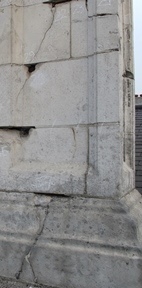 |
||
| Above left: understanding the weathering characteristics of natural building stone is an essential part of survey work. Weathering has accentuated the natural bedding planes of the limestone and eroded the softer beds of this late-19th century masonry. Progressive decay is especially problematic in the case of projecting elements where there is an increased risk of failure and detachment of fragments. Above right: corroding ferrous metal cramps can cause considerable damage in the form of cracking and spalling, as visible in this Portland stone chimney where extensive stone indents are now required. | |||
In some cases the installation of lead protection may be an option. Lead sheet weatherings have been extensively used historically to protect cornices, pediments, copings and other exposed details from weather. They can prolong the life of stonemasonry if properly detailed, with welted joints and a drip to throw rainwater (in accordance with Lead Sheet Association guidance) and may offer an alternative to extensive stone replacement.
The installation of leadwork involves cutting a chase into the masonry above to fit a cover flashing, and this will need to be weighed against the potential benefit of protection that lead can provide. In addition, weatherings will inevitably have some impact on the appearance of the building (see illustration), although this may be relatively minor when seen from ground.
Cracks
Visible defects commonly include cracks and fractures which may range in scale from hairline to 10mm or more. It is important to determine the cause of fractures and whether they relate to hidden elements such as imbedded ferrous metal fixings, or to structural movement.
Dog cramps were widely used in historic masonry to provide additional lateral restraint where necessary. They were often placed relatively near the stone face and when corrosion occurs the expansion of rust leads to characteristic fractures and spalls occur, normally at the upper corners of the affected blocks.
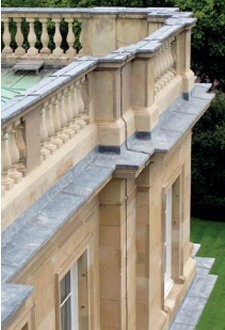 |
|
| Lead has been used extensively on this Grade I listed building to protect vulnerable historic masonry, such as the Bath stone copings and cornices. |
The use of non-destructive testing methods like metal detection can be helpful to locate concealed cramps and reinforcement of historic repairs. Gentle tapping (‘sounding’) with a small metal tool helps to detect detachment where there are visible spalls, fractures or other defects.
Old cement repairs
Past repairs, as well as visible stonemasonry defects, should be checked. Unfortunately, many historic buildings exhibit a legacy of historic repair work in unsuitable materials, often in excessively hard and impermeable mortars such as the ubiquitous ordinary Portland cement (OPC). In the worst cases large areas of masonry were refaced with OPC mortars.
Commonly used in the past, as an inexpensive and easy repair option, this practice unfortunately still occurs, often without regard to original joint lines and other historic features.
This kind of repair exacerbates the decay of more porous and permeable underlying stone, and failure eventually occurs at the interface between the two. Such large scale re-facing of stones should never be considered a repair solution or alternative to correctly detailed stonemasonry repairs (indents, replacement units) based on traditional masonry skills.
Unfortunately, however, past repairs of this kind, from small to large scale, are often so extensive that the best that can be practically achieved is to renew those that have failed and detached, and are evidently causing problems, and leave those that remain well bonded, provided they are not posing a health and safety risk.
PRINCIPLES AND PRACTICE – REPAIR OPTIONS, CRITERIA FOR USE & OTHER ISSUES
One principal aim of remedial work is to effect repairs with minimal loss and alteration of historic fabric. Maintaining the integrity of masonry and restoring essential detail, such as weatherings, where damage or loss has occurred are also key objectives.
In practice, replacement may be the best option if the structural stability or weathering function of individual stones is completely compromised and cannot be restored with localised surface repair. However, isolated and discrete defects on a block, such as a spall from a corroding ferrous cramp or decay adjacent to an open joint, can often be repaired using stone indent repairs whereby a new stone is cut and shaped to fit the damaged area.
For sheltered or relatively small areas lime mortar repairs may be used. A range of lime binders are available, from high calcium lime (with or without additives such as pozzolans to enhance performance) to natural hydraulic limes (NHLs) graded from 2 to 5 based on strength, to suit various exposures.
For both indents and mortar repairs the damaged surface must be carefully prepared. Lack of surface preparation and lack of adequate reinforcement or armature are two of the most common causes of failure of past repairs. The stone surface should be cut back to sufficient depth that the indent or mortar will remain safely in place and the edges of the repair cavity undercut to hold the repair.
Although it is often possible in the case of larger indent repairs to use mechanical (disc) cutters to remove the bulk of the damaged stone, the final dressing of the repair cavity, the back and sides, should be done by hand with sharp masonry chisels to form well-cut, neat edges to the repair. The interface between a stone indent and repaired stone should be very fine, not a masonry joint, for maximum durability. Good indent repairs require a high level of masonry skill.
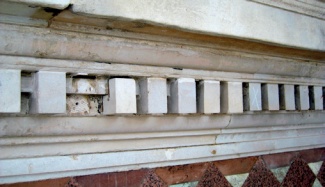 |
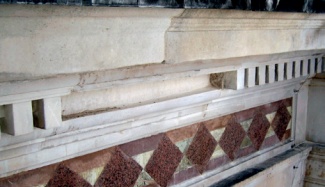 |
|
| Dentils in a cornice which had been poorly repaired in the past with machine-cut dentils that were larger than the originals and inadequately bonded to the underlying stone. | After removing the failed replacements, the stone was dressed back to enable a more effective indent repair with a new section of dentils worked as a single piece of stone. | |
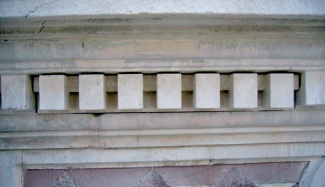 |
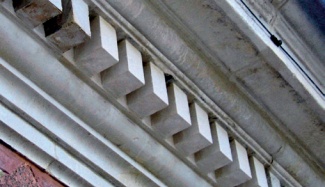 |
|
| The new indent unit loosely slotted into the cavity, ready for fixing | The finished piece after fixing with new stainless steel dowels and grouting at the interface |
Trials and exemplars should be part of any repair contract to ensure at the outset that the required standard can be achieved. Historic indent repairs of very high quality are often found on historic masonry buildings, and are testament to what is possible. These historic repairs often have a curved profile, following the edge of a defect to minimise repair size and avoid the mechanical appearance that can result when indents are cut square.
The following general rules should be observed when carrying out historic masonry repairs:
- Historic masonry joints must be followed in all repair and replacement work. If repairs bridge masonry joints, evidence of the original construction (joint details) will be lost, and there is a risk of the repair fracturing along the joint lines.
- Stone indents to exposed edges, for example on the nosings of cornices, steps, and copings, should be dovetailed in place to secure them.
- In general, indent repairs should be anchored by dowels (normally corrosion resistant stainless steel or phosphor bronze) inserted into fine drillings into the indent and the back of the repair cavity, and bonded with resin designed for this application. Resin should be used in the drilling only and not smeared across the stone surfaces at the interface.
- Lime grout is the appropriate material for bonding the stone interface, which must be completely filled to avoid rainwater penetration using grout specifically designed to suit the exposure, stone type and colour.
- Both stone indents and replacement stones should follow the original profile of mouldings as far as these can be determined. This can be difficult with weathered surfaces and evidence should be sought in the least weathered areas and profiles recorded onto a permanent template, such as zinc.
- Mechanical saw marks on stone faces are completely out of character and should not be accepted. Stone repair faces should be finished by hand and dressed to replicate original tool marks of the historic masonry.
- Masonry joints finished as part of stone repair and replacement work should also be visually and physically compatible with the existing.
Provided these general rules are followed to a high standard using good masonry skills, repair work, and in particular indent repairs, should provide a good long term solution and enhance rather than detract from the historic masonry.
~~~
Recommended Reading
G Allen et al, Hydraulic Lime Mortar for Stone, Brick and Block Masonry, Donhead, Shaftesbury, 2003
J Ashurst and FG Dimes, Conservation of Building and Decorative Stone, Butterworth-Heinemann, Oxford, 1998
British Standards Institution, BS 8221-1:2012 Code of Practice for Cleaning and Surface Repair of Buildings, BSI, London, 2012
Ian Brocklebank (ed), Building Limes in Conservation, Donhead, Shaftesbury, 2012
English Heritage, Practical Building Conservation: Stone, Ashgate, Farnham, 2012



